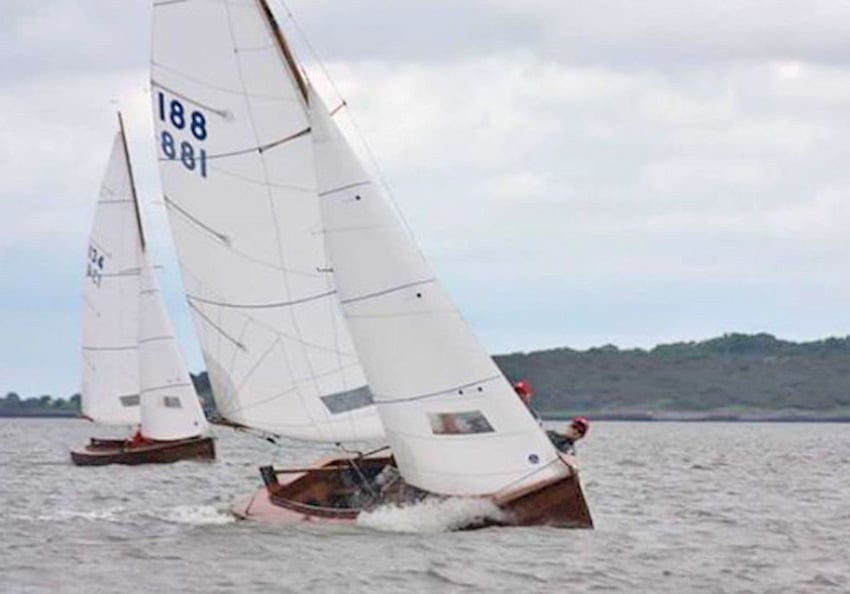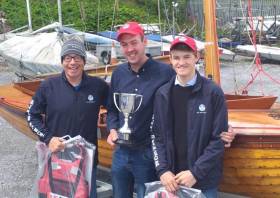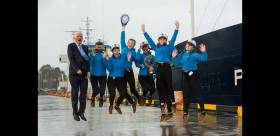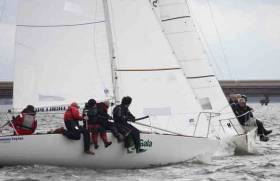Displaying items by tag: Foynes Yacht Club
Foynes Yacht Club Present Cheque to RNLI
Foynes Yacht Club Commodore Bev Lowes has presented a cheque for €2,100 to the RNLI raised at a table quiz held earlier in the year.
The cheque presentation was made on behalf of Foynes Yacht Club during its Commodores Day on the Shannon Estuary last Sunday.
Foynes Yacht Club on the Shannon Estuary continues to receive donations ten days after completing its charity Sail for Darkness into Light.
"To date, we have collected nearly €3,000, but donations are still coming in, so the final figure will be issued when all monies are counted", Patricia McCormack, Foynes Yacht Club, Vice-Commodore, told Afloat.
"There was a great turnout on the 6th of May. An early start but for a great cause", she added.
After the fundraising sail, the Foynes Yacht Club fleet returned to the clubhouse for breakfast.
Foynes Yacht Club's March Chill Series came to an end last Sunday on the Shannon Estuary, with the host club's Killian Reidy in first place in the Doyle Shipping Group-sponsored event.
Second was Fionn McGibney of the neighbouring Tarbert Island Maritime Club.
Tralee Bay Sailing Club's Billy Doyle was third.
 Fionn McGibney, Tarbert Island Maritime Club, who took second place at the DSG March Chill Series, with Mary McCormack, Dinghy Class Captain, and Bev Lowes, Commodore
Fionn McGibney, Tarbert Island Maritime Club, who took second place at the DSG March Chill Series, with Mary McCormack, Dinghy Class Captain, and Bev Lowes, Commodore
 Billy Doyle, Tralee Bay Sailing Club, who took third place at the DSG March Chill Series with Mary McCormack, Dinghy Class Captain, and Bev Lowes, Commodore.
Billy Doyle, Tralee Bay Sailing Club, who took third place at the DSG March Chill Series with Mary McCormack, Dinghy Class Captain, and Bev Lowes, Commodore.
Foynes Yacht Club Raises €700 for RNLI on the Shannon Estuary
Foynes Yacht Club's annual RNLI Quiz has raised €710 for the lifesaving charity.
The quiz winners were the Foynes Yacht Club Sailing Instructors; Mary McCormack, Amelie Brogan, Bev Lowes (Commodore), Isabel O’Shea, and Sarah Guina.
Tonight, the Shannon Estuary club will hear speaker Vincent Murphy's account of the life and times of Foyne's own solo circumnavigator, Conor O'Brien.
Circumnavigator Conor O’Brien Presentation at Foynes Yacht Club
Foynes Yacht Club on the Shannon Estuary welcomes Vincent Murphy on Friday evening, 13th January, at 7.30 pm, to give a 100th-anniversary presentation on the life of the late circumnavigator Conor O’Brien.
In 1923-25, O'Brien became the first amateur skipper to circle the world south of the Great Capes.
O'Brien's boat Saoirse was the first small boat (42-foot, 13 metres long) to sail around the world since Joshua Slocum completed his voyage in the 'Spray' from 1895 to 1898.
O'Brien documented it as a journey in his book Across Three Oceans. The voyage ended at the Port of Foynes, County Limerick, Ireland, where he lived on Foynes Island.
 The Foynes Yacht Club poster for the100th-anniversary presentation on the life of the late circumnavigator Conor O’Brien
The Foynes Yacht Club poster for the100th-anniversary presentation on the life of the late circumnavigator Conor O’Brien
Born in 1880, Conor was a heroic sailor with a huge commitment to Irish Home Rule and a fluent Irish speaker. In 1914 he assisted Erskine Childers in the famous gun-running saga of Irish history before circumnavigating the world.
The FYC entry fee is €5 and proceeds to the RNLI.
Foynes Yacht Club Frostbite Dinghy Series Returns After a Two-Year Hiatus
There was great excitement at Foynes Yacht Club on the Shannon Estuary for the return of their SRL Frostbite Open Dinghy Series, after a two-year hiatus writes FYC Dinghy Class Captain, Mary McCormack
Six races were held over four weekends. Conditions were somewhat perfect throughout apart from the second weekend where racing was abandoned due to a lack of wind.
Dylan Reidy led the Series through with picture-perfect results. Dylan was challenged by another local laser sailor Christopher McDaid and Killaloe’s RS400 with Govan Berridge and David Coleman on board, and his younger brother Killian and Conor Daly on their Topaz Omega. Other boats battled further down the fleet.
Class 2 was led by Kate O’Regan followed closely by Ivan Joyce in his Skipper 14, which unfortunately was demasted during week 3, as well as her younger brother Brendan and another local sailor Abbie Fitzgerald.
The month brought fantastic racing as well as fantastic fun and club spirit which was sorely missed over the two-year break due to covid.
The Series could not have taken place without Sponsors SRL Refrigeration Ltd, OODs Donal McCormack and Raymond McGibney, the club members, volunteers, both on the water and onshore, as well as the competitors, especially travelling boats.
Results
Class 1
Dylan Reidy - FYC - Laser
Govan Berridge & David Coleman - KSC - RS400
Killian Reidy & Conor Daly - FYC - Topaz Omega
Class 2
Kate O’Regan - FYC - Topaz
Ivan Joyce - FYC - Skipper 14
Brendan O’Regan - FYC - Oppie
'Elegant Explorer' Makes Final Nostalgic Calls to Irish Ports Including Anchorage off Foynes Island
A luxury cruiseship nickmamed the 'Elegant Explorer' celebrated its final call to Foynes, Co. Limerick by anchoring off the port on the Shannon Estuary.
The call of Prinsendam operated by Holland America Line was according to SFPC a welcome tourism boost for the mid-west region as cruise passengers arrived by tender to visit Foynes (via Foynes Yacht Club). The unique event to anchor off Foynes Island took place on June 13th.
Prinsendam was making a nostalgic call after a career spanning 17 years sailing around the world under HAL colours. Afloat adds the ship was sold to German cruise company Phoenix Reisen and the acquistion actually took place last year. This saw the 37,938grt chartered back to HAL until expiring next week (Monday, July 1st).
The 204m ship with a capacity for 800 passengers took anchorage at 6.30am off Foynes Island and remained for 12 hours during. Hundreds of tourists were tendered ashore to visit the west Limerick town and attractions beyond among them west Clare and to Dingle in neighbouring Kerry.
Approximately 100 passengers stayed local, making their way to Foynes village where they enjoyed the must-loved, award winning Foynes Flying Boat & Maritime Museum.
Shannon Foynes Port Company (SFPC) CEO, Pat Keating said they were delighted to facilitate the cruise ship in the busy port. “We’ve had cruise ships dock in Foynes before but this is the first time a cruise vessel anchored specifically off Foynes Island. Passengers ferried by tender to the pontoon at Foynes Yacht Club where they boarded coaches for various destinations or simply enjoyed Foynes itself on foot. “It delivered a really nice tourism boost for the area, with the passengers visiting Limerick, Clare and Kerry. It was great to see the Flying Boat & Maritime Museum getting an extra boost. It’s a fantastic tourism attraction and deserves as much recognition as it can get and all those who visited it will pass on the good word about it.”
Mr Keating added that while cargo is the core activity, the port authority was delighted to welcome this business. “It was a busy morning and the cruise ship brought a great buzz to the area. From an operational perspective, all passengers were transferred safely and comfortably to and from the vessel. “By anchoring at Foynes Island, cruise liners can easily be accommodated at Foynes as it gives us more capacity in addition to the actual docks itself. Hopefully we will get to welcome many more cruise vessels to Foynes.”
Despite the relatively small size of Prinsendam and low height the cruiseship has during a career dating to 1988 (Afloat will have more) been able to navigate interesting routes where most other such ships cannot. The most recent voyages have included the Amazon, the Caribbean, South America, Antartica and now finally Europe where the ship with a crew of 340 will spend this week with the HAL fleet.
The last voyages include the Mediterranean, Iberian Peninsula, British Isles, Ireland before making her final farewell on a 14-day expedition to the Norwegian North Cape.
Another cruiseship is scheduled to dock on the Shannon Estuary next week on Friday, July 5th.
Innocence Wins Again: Foynes Crew Crowned Munster Mermaid Champions For Fourth Year Running
Foynes Yacht Club boat Innocence, helmed by Darragh McCormack and crew Nigel and Jack Young, claimed their fourth Munster Mermaids title in a row at the regional championships held at their home club on the Shannon Estuary his past June Bank Holiday weekend, writes Patricia McCormack.
The weekend got off to a bit of a slow start with racing postponed ashore for an hour in the hope that more breeze would fill in. Thankfully a breeze of 12-15 knots arrived, making for perfect racing conditions for the Mermaids.
Nine boats took to the start line for the first warning signal as 12.25pm. The first upwind proved to be very competitive with 121 Red Seal, helmed by Darragh Dineen and crew Conor and Louise Magner, and 188 Innocence rounding the windward mark first and second respectively.
There was a bit of a change-up in races on the first downwind with Innocence taking the lead and holding it comfortably for the rest of the race.
Meanwhile, there was a serious battle going on for second, third and fourth place between 100 Zest, helmed by Anna Lowes and crew Bev Lowes and Conor Clifford; 135 Cara II, helmed by Frankie Browne Snr and crew Frankie Browne Jnr and Brendan Dunne; and 119 Three Chevrons, helmed by Vincent McCormack and crew Michael Lynch and Roisin McCormack. The first race was definitely an exciting start to the championship.

The second race saw 10 boats on the start line with 54 Hycilla, helmed by Mark McCormack and crew Cathal McMahon and Luke McCormack, making its way to the start line for its debut after nine years out of the water.
The rest of the day didn’t fall short with excitement. The close racing was a magnificent sight for spectators and fantastic fun for everyone taking part.
With the forecast for Sunday not looking great the OOD Raymond McGibney made the executive decision to hold all four races scheduled for the weekend on Saturday. This came with no bother with swift mark layers and a good crew around the OOD.
The last race was certainly an interesting one for Three Chevrons and 134 Jill, helmed by Paul Smith and crew Anne Smith and Pat Mangan, battling for third overall. 161 Pearl helmed, by Noel McCormack and crew Tadhg O’Loinsigh and Mary McCormack, managed a second in Race 4.
Meanwhile, 165 Seafox, helmed by Oisin Finucane and crew Christopher McDaid and Sean Finucane, and 191 Maybee, helmed by Paddy Archer and crew Packer Thorne and Breda Magner, continued to battle with one another.
Overall it was a clean sweep for Innocence with four bullets on the day, and their fourth Munster title in as many years. Second place went to Cara II followed closely behind by Three Chevrons. Once again a fantastic weekend of racing for the Mermaid fleet.
Generating Energy Using Pressure Pads on Ships Leaves Limerick School on Crest of Wave
#marinescience - One of Ireland’s maritime commercial hubs, Foynes, in Co Limerick was where innovation was in rich supply as schools presented ground-breaking concepts for sustainable energy sources of the future.
The schools congregated at the biennial Shannon Foynes Port Company (SFPC) ‘Compass’ Transition Year Competition that was held last Friday.
Laurel Hill Secondary School was the overall winner which walked away with the honours thanks to their ‘Working Waves’ presentation. This is based on generating energy from ships on the move through a pressure pad system that feeds into an electricity generator and battery in the hull.
But, as judges highlighted, the competition was the most tightly marked, the most competitive and delivered the highest standards in its six-year history.
The Limerick city school, who were presented with their award by Minister of State at the Department of Finance Patrick O’Donovan, was one of five finalists who presented in front of 300 people at the Foynes Flying Boat & Maritime Museum.
They walked away with the top prize of the perpetual trophy, a €2,000 cheque for their school and iPads & COMPASS gold medals for each of the team members. All runners up received a COMPASS silver medal and a sailing day on the Shannon Estuary sponsored by the Foynes Yacht Club Sailing Academy.
The J24 Western Championship weekend was characterised by great racing, sailing conditions and fantastic hospitality in Foynes Yacht Club.
The Championship - which saw boats from all around the island of Ireland take part - culminated in a great two final races in southerly breeze of 25 knots with gusts up to 30 knots.
Principal Race Officer Raymond McGibney chose Race Area Two and set a course east of Foynes Island.
The penultimate race got underway on schedule with JP McCaldin on Jamais Encore from Lough Erne / Sligo YC and Flor O’Driscoll, Hard on Port, from Royal Saint George Yacht Club duelling for the championship title. After a difficult first beat, only about 25% of the fleet flew spinnakers on the first downwind leg resulting in a big change in the leaders on that leg. In the testing conditions, Hard on Port fell outside the top three giving the title to the Lough Erne boat with one race to spare.
The last race of the day got underway with a clear start with the boats taking the right hand side of the course gaining at the top. Three rounds of the course were completed with the HYC K25 Team leading from the start to the finish followed in second place by Flor O’Driscoll, and Finbarr Ryan on Jelignite in third. Battles continued throughout the rest of the fleet with Jumpin Jive from Greystones YC representing the east coast on the podium in third place. After finishing the fleet sailed to the safe haven of FYC where all were quickly lifted from the water by BCS Crane Hire LTD.
 First place for the Jamais Encore crew from Lough Erne Yacht Club
First place for the Jamais Encore crew from Lough Erne Yacht Club
J/24 Class Association of Ireland President, Flor O’Driscoll, commented with delight about the rejuvenation in the J/24 fleet. This event had two newcomers to their regional events, the new HYC K25 Team on Scandal sailing a superb event and finishing first in the Silver Fleet, three points ahead of another newcomer Fergus Kelliher on Jibe from Tralee Bay Sailing Club. Third place went to Dave Lane & Sinéad Enright on YaGottaWanna from the Royal Cork Yacht Club.
The local contingent was led by Gala Racing from Foynes YC, coming in fifth in Gold & seventh place overall.
The prizegiving took place in the club with all competitors in attendance. Sponsors Yachtsman Euromarine, UK McWilliam Sailmakers, North Sails, Quantum Sails, BCS Crane Hire LTD and Cliffords Cash and Carry were thanked. A special thanks went to the members of FYC for all their help over the weekend.
Yachtsman Euromarine J24 Western Championships Overall -
Gold Fleet
1st IRL5278 Jamais Encore JP. McCaldin Lough Erne / Sligo Yacht Club
2nd IRL4794 Hard on Port F. O'Driscoll Royal St. George Yacht Club
3rd IRL3060 Jumpin Jive M. Usher Greystones Sailing Club
Sliver Fleet
1st IRL4212 Scandal HYC K25 Team Howth Yacht Club
2nd IRL4252 Jibe F. Kelliher Tralee Bay Sailing Club
3rd IRL5098 Ya Gotta Wanna D. Lane / S. Enright Royal Cork Yacht Club

































































